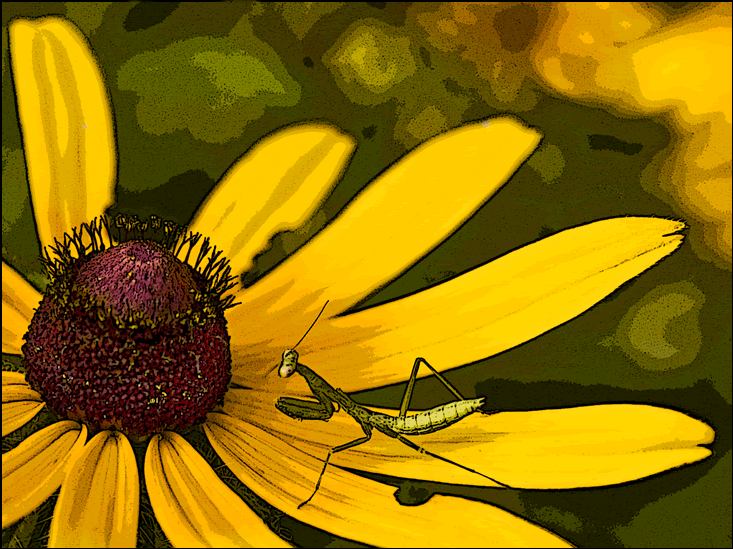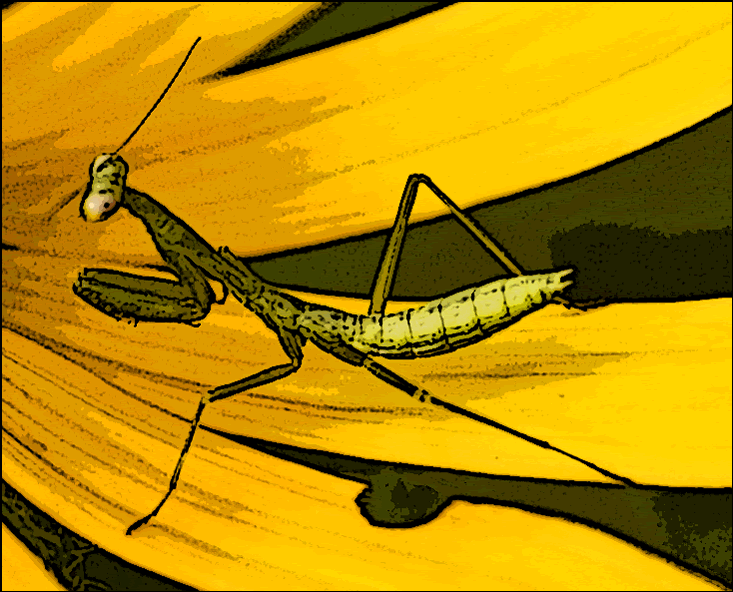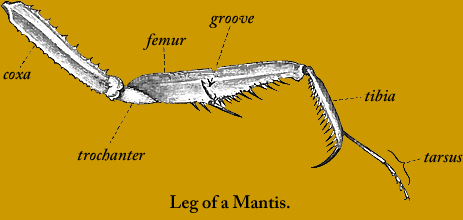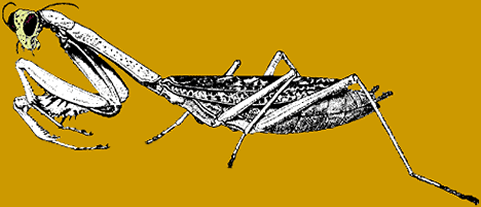|
|
|
|

 Mantis Nymph on Rays of Susan
Mantis religiosa and Rudbeckia hirta Do you see menace or divine inspiration? The merciless predator or the mysterious prophet? Friend, foe, or just another bug in the garden? Questions float on the quiet ether of the cottage tonight, reviving the sweet spirit of inquiry. We observe a photograph, an array of hidden code and symbols, burned by the afternoon light onto a silicon disk. See it. The insect stands boldly on golden petals. Poised and alert, it rides a frothy wave of pixels into this wandering night. Like alway, we wonder: What marvels shall the image reveal to us over the course of a leisurely reflection? The popular image of the praying mantis raises an interesting set of contradictions. It can summon up the dark side, a violent realm of bloodthirsty predators and ravenous cannibals. It can inspire flights of fancy into a magical wonderland of soothsayers, pathfinders, and shapeshifters. It can be the ruthless killer lying in wait for the ambush, or a kindred believer facing a holy shrine to pray to the almighty. To some the mantis is the swift heavenly horse of courage and fearlessness, but to others it is a mule slayer and the devil's racehorse. The stories, as they say, are legion. What lens filters your looking glass? Our study of the mantis wanders into a maze of counter-intuition, where paradox and the Contrarian are waiting at the center to point us who knows where. Do you peer into the outside world with wariness and caution, looking into shadows and hidden places, while the one walking beside you finds fantastic creatures in the sunlit clouds high-up in the heavens? Do you stroll the passage with eyes wide open, trusting the Fates or the Creator to guide you safely through while you whistle and sing? Or does every day become a challenge in the cold, cruel world? Is it a talisman or a sabre you strap with golden chain or leather girdle securely to your persona? Who appears on your silver screen: a wizard at center stage with hope and an answer, or a charlatan behind the curtain with vain promises and vapid lies? Elixir or snake oil in the bottle on your night stand, the wine skin at your table? Perhaps, just perhaps — the horror! — you've consigned your life to the muddle of self-absorption and joined the throng of the unaware, who insulate identity in a surface skimmer, caring naught for the journey but solely about the next manic destination. If so, please don't let me know. Go scribble your confession on a blackboard outside the way station at Desolation Row. Find comfort where ye may. How we choose
to perceive and interpret — and if necessary, to judge — the surface of things
"Beauty is truth, truth beauty," — that is all  The nymph above was about 19 mm (3/4") in length on the afternoon of the photograph. The praying mantis found favor over the ages because its outward appearance evokes sentiments of pious devotion to God. It became the personified prophet, the good bug. "This atrocious little savage has had the fortune to acquire a peculiar reputation for wisdom and saintliness," an anonymous writer for Science Monthly lamented in 1888. "For thousands of years, and in all parts of the world, it has borne this character. The cause has been that it habitually assumes an attitude that appears devotional, and it was supposed to spend a large portion of its life in prayer." Amen — then strike! The attitude of prayer, so endearing to the anthropomorphic eye, expresses not reverence, but the ruse of the patient predator. Motionless, its stout raptorial forelimbs covered in spikes, the mantis is devoted not to the Creator, but to the hunt. Observers tell us a mantis can wait for hours without apparent movement, setting its ambush in plain sight of the coming morsel. "When prey is sighted, they often creep up silently, much like a cat, and when close enough make a quick dash, seizing their prey with their spined forelegs," Mark Vernon Slingerland of the Cornell University Agricultural Experiment Station at Ithaca, New York, wrote in 1900. Entomologist Professor Slingerland, convinced he had discovered the first instance of the Mantis religiosa as a viable species on the American continent, saw the creature as an "insect friend" and lauded the "foothold" it had recently established in the fields and meadows of New York State. "While this new addition to the insect fauna of America does not deserve to be revered by us as is apparently done in some parts of the Old World, yet, as it is decidedly an aid to man in his efforts to overcome his insect enemies, it should receive kind treatment, protection, and thoughtful consideration," the professor wrote. "Its food consists almost entirely of other insects, and a large proportion of these are injurious insects, like grasshoppers and flies.... Our farmers and fruit-growers need the aid of every Praying Mantis that can possibly safely escape the vicissitudes of an insect's life, to help them in their warfare against injurious insects." Beekeepers beg to differ, taking an apiarian stand on the side of owls, frogs, snakes, and lizards, predators of the mantis. Branding it a "depraved insect," Albert John Cook, Professor of Entomology at Michigan State Agricultural College, wrote derisively of the sacred name, concluding that "it might well be preying mantis" because of its craving for the honeybee and other beneficial pollinators, including the hummingbird. Professor Cook's 1883 text, The Bee-Keeper's Guide; or Manual of Apiary, referred to the Carolina mantis as "a corpulent 'walking stick' with wings." 
Professor Cook's anti-mantis stance appears in the Ninth Edition of his Bee-Keeper's Guide, which predated by 17 years Professor Slingerland's fawning treatise in praise of the creature's new "foothold on the American continent." Here the casual naturalist wades into the murky realm of the specialist, aware of the potential to err but eager to pursue an inquiry to its logical conclusion — and fascinated by the intellectual fragility of perspective and bias. Professor Cook, we surmise, vented his spleen on the Stagmomantis carolina, native to the continent but unable to produce eggs hardy enough to survive cold Yankee winters. Professor Slingerland's "new beneficial insect" was a mantid of a different color. Adult specimens of the New York mantis, gathered as eggs near Rochester by "a little girl," then raised to maturity in a Cornell laboratory "breeding cage," were sent to an expert, a "Mr. Scudder," who admitted that the case "was very perplexing." Mr. Scudder's report of 20 September 1900 stated: "I never for a moment thought it was anything but an American species.... Everything in the New World tables brought it down haltingly to Stagmomantis, and yet it was no Stagmomantis, so I turned just now to the Old World Series, and there at once I brought it down to Mantis, and, on comparing specimens, to Mantis religiosa, the common European form." Bolstered by a subsequent dispatch from the "Principal of Public School No. 11" in Rochester that Old World mantids were abundant near the school — "one was found sunning itself in the middle of the day on the sidewalk," Principal Samain wrote — Professor Slingerland pledged to "endeavor to establish it at Ithaca." Did he? Or did Nature take her course? No wonder we find it so challenging here in the orderly universe of Crow's Cottage to precisely classify the specimens of flora and fauna captured by Beau Bosko's digital photography and offered to us for study, meditation, and presentation on a page of the Glossary and Compendium. To this day, for example, entomologists cannot agree on the scientific order of the mantids. Some put them into the Order Dictyoptera, while others contend they belong to the exclusive Order Mantodea. Some claim they are proto-cockroaches, but the claim cannot be proved. Descending the ladder of classification, we can usually determine the genus of a specimen without too much grief. However, pinpointing the species often becomes an act of speculation and educated guesswork, especially when the specimen available for study appears as a two-dimensional photograph with a constricted perspective based on the desires of art rather than the requirements of science. Nevertheless, here goes:
Praying Mantis

Bed of Susans The adolescent mantis shown on this page stands on the petals of the black-eyed Susan like a sculpted statue, practicing the posture of the hunt. A nymph, it wears no wings. They are destined to appear with the shedding of the creature's youthful exoskeleton at the next molt. By winter, should it survive the ceaseless predatory drama in the garden, our specimen will have reached the end of its three-to-four-season life span. The most outwardly pious among us can move secretly in the shadows as a cryptic ravenous beast. Let us pray for discernment should one of them venture too close to our blood and our brood. Brother eats brother, sister devours sister in the cannibalistic mantid struggle for primacy and survival. For the innocent and the optimistically imaginative among our kind, life's course overflows with wonders and miracles, the fantastic and the sublime. May they find protection from Fate or shelter 'neath the wings of a diligent Guardian. May they hold dear to their visions long past the dawn, even past the moment when the sad teacher arrives with Severity. A mantid named Queen Bess became companion in the nineteenth century to Charlotte Taylor, who petted the creature during the day and then tethered her to the bedpost at night with a strand of silken thread. Queen Bess took flight in her circumscribed orbit and made sport of the mosquitoes who ventured near her sleeping charge. One night, having heard of the mantid's prophetic powers, Mrs. Taylor asked her insect queen to foretell the morrow. Should I, or shouldn't I ride that horse reputed to be wild? The praying mantis hung her head beneath her front legs, signifying No — and experience soon confirmed the answer to be just and right when two days later the horse threw his rider, who died. Mrs. Taylor sought a second prophecy, and this time Queen Bess stood erect and spread her wings. Yes! "I was taught by the saddest teacher, Experience, that whenever Queen Bess's refusal went unheeded I was the sufferer.... I learned to obey the hidden head more carefully than any other, I am sorry to say; and I never, in one single instance, knew her to refuse her opinion; and I never knew it to be wrong in whatever way she announced it," Charlotte Taylor wrote. So it reads in Harper's New Monthly Magazine of March, 1862. Queen Bess disappeared one night. Charlotte Taylor speculated that the mantis had flown into the wilds to become one with "green fields and loving trees." Not so. Some months later, the prophet's body was found, her front claws snared in the silk fringe of the bed. Unable to extract herself from the trap, her majesty the mantid queen had starved to death while her human mistress slept and dreamed. So very late now. The salamanders have lost their wicks and everyone around us is sleeping. We haven't found time to tell about the mantis as shape shifter, or the mantis as Moslem Turk and worshipper of Allah, or the mantis as balm for bed wetters, or the story of the mantis of great strength and courage who stood down a charging chariot. Chinese philosopher Chuang-tse tells that tale. Somewhere this very night, mantises are imprisoned in bamboo cages, waiting to be sent into deathly battle, one against another for the amusement of humans. It is said their spit can slay a mule. pagana, sancta, supplicaria, oratoria, mendica. Let us sing a canticle of praise for another day justly done.  One and All with Thirteen Rays: We weren't looking for the praying mantis. Instead, we were counting the petals on the black-eyed Susans in one of the flower beds at Crow's Cottage, when suddenly we spied the little mantis nymph, who was standing on a Susan to the right of this specimen. Every one of the multitude of Susans wore thirteen rays. The book says that typically a black-eyed Susan wears ten to twenty rays. And.... The slender dark tendrils forming a ring and extending upwards from the base of the flower's cone are disk achenes, or one-seeded fruit. You can see them clearly in the image at the top of the page. They look like trees encircling an ancient pagan temple. They are similar in function to the winged achene of the maple and the ash, technically known as a samara. To us kids in the long ago, they were helicopters. As for our counting of petals, it's not obsessive-compulsive. It's science in action. The Preying Mantis
When the praying mantis prays
Stop your singing
Small he is but strong,
In his stomach surely
By Paul Carus L I N K S
P O S T S C R I P T "The old primal animal instinct in man to hunt and kill, necessary in savage life, still persists, and is sufficiently strong without special cultivation. At present the lower animals need no longer be regarded as enemies to be destroyed, but rather as friends to be cultivated, or as curious objects to be studied. The tenderness and finer emotions which come from the study and care of creatures inferior to ourselves are elements essential to the highest character." — from "PREFACE," Glimpses of the Animate World; Or, Science and Literature of Natural History, For School and Home, by James Johonnot (D. Appleton and Company New York 1888). The quoted text was attributed by the author to have been written on March 3, 1883, at Princeton, N. J. Notices announcing new entries for Crow's Cottage Glossary and Compendium are sent by e-mail express to my list of family, friends, students, and fellow travelers. If you've come here by some other means, I invite you to write me at the address below so I can add you to the list. It's a private list, shared with no one and guarded to the max by a flock of warrior crows. Or protected by magic fairies with their tricks of illusion. Aggressive or pacific — you choose — the guardians are in our service to ensure your privacy. Ebenezer Bowles Tuesday, July 27, 2010 |
|

|
|
|
 reveals much about point of view, attitude, and learned behavior. What is real and what is not in our evolving picture of reality? More importantly, as survivors, we sharpen the ability to see beneath the surface, to look behind the outward image and identify intent and purpose, threat and opportunity. The better we do so, the more grief we spare. If inclined toward competition, the more advantage we gain. If inclined toward the finer emotions, the nearer we move to truth and beauty.
reveals much about point of view, attitude, and learned behavior. What is real and what is not in our evolving picture of reality? More importantly, as survivors, we sharpen the ability to see beneath the surface, to look behind the outward image and identify intent and purpose, threat and opportunity. The better we do so, the more grief we spare. If inclined toward competition, the more advantage we gain. If inclined toward the finer emotions, the nearer we move to truth and beauty.